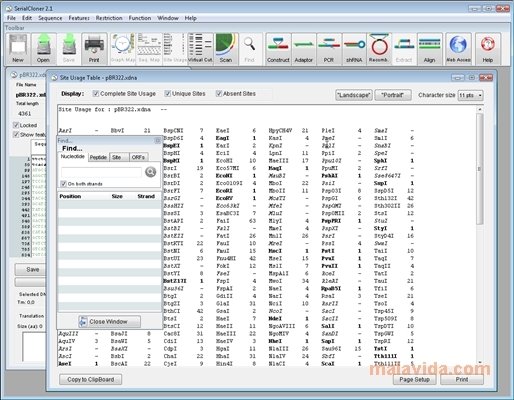

Now that you have the ORIGIN signal that indicates a sequence follows, you are ready to paste in the sequence on the next line. Therefore on the line just above //, type ORIGIN and hit return. The sequence has to be prefixed by a signal. The sequence will be placed right before the // found at the end of the. Once it is saved you are ready to edit it safely. gb file as another name, preferably in a new directory. So that you don't destroy your UGENE files and projects, immediately save the. note="part of OMES-2, primer, rev primer for RPR1 region note="112 NUCLEOTIDES FLANKING RPR1 GENE" note="ADH1 terminator from S cerevisiae" note="portion of DNA from Arabidopsis with PRORP3 on it" note="Saccharomyces cerevisiae S288c chromosome XV" note="OMES-P1 primer, fwd primer for RPR1 region of note="28 nucleotides flanking insert (prefer 40)" It will look something like below: LOCUS Annotations 2
#Serial cloner xdna pet28a serial
gb to make a Genbank file in a format that Serial Cloner will identify and use. Step 2: Prepare a 'bridging file' to be used for importing into Serial Cloner In this case you can skip over step #2 and go right to step #3. However, when using the Cloning action under Actions to build molecules, you can alternatively just end up a Genbank-like formatted that INCLUDES BOTH the sequence and the annotations and there will be no associated. Your project folder may or may not have additional files in it with the same extension depending on how you choose to work with UGENE and its project and documents. You need to identify the specific Genbank-like formatted feature annotations file related to the specific molecule you are trying to port over to Serial Cloner. The file with the feature annotations will end in. Your project folder may or may not have additional files with the same extension in it depending on how you choose to work with UGENE and its project and documents. You need to indentify the specific sequence file related to the specific molecule you are trying to port over to Serial Cloner. The UGENE sequence will be a FASTA format sequence file ending in.

You do not need any information from this file to perform the conversion, but examining it in your text editor or UGENE may help you identify the specific, related sequence and feature annotations files you need to do the conversion. The sequence and annotations files should be together in the project folder along with your project data information file that ends in the extension. Typically when you are just starting to use UGENE, each molecule will have three files:
#Serial cloner xdna pet28a how to
How to do this requires some examination of your UGENE files. You'll need to find the sequence and the associated annotations that UGENE generated. Step 1: locate UGENE-generated files you'll need Maps) with features and restriction sites indicated.
#Serial cloner xdna pet28a full
One of the reasons for possibly doing this is in order to take advantage of the tools in Serial Cloner that UGENE seems to lack/approaches differently, in particular Serial Cloner allows for easily making and printing full graphical Graph Maps or classical restriction sequence maps ( Seq. The annotated features from Unipro UGENE will ultimately be intact and displayed in Serial Cloner if you follow this process. This describes how to take a sequence with annotated features and move it into Serial Cloner with your favorite text editor and minimal effort. Converting a Unipro UGENE sequence to Serial Cloner


 0 kommentar(er)
0 kommentar(er)
